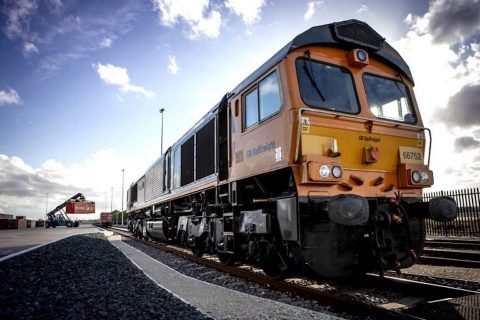Cloburn Quarry red granite gives Carstairs project a distinctive hue

There’s a distinctive Scottish granite adorning a Scottish rail project. The red granite ballast is used in the extensive remodelling of Carstairs Junction, the critical interchange at the northern end of the West Coast Main Line. The triangular junction provides access to Glasgow and Edinburgh, Scotland’s largest cities. The good news is that materials are being delivered from the quarry railhead direct to the work site.
The advantage of the quarry railhead has allowed business as usual during the works programme. That means visits to the Cloburn branch line by trains of Network Rail’s impressive autoballaster wagons.
Cloburn Quarry, one of Scotland’s largest independent quarry operators, supplies ballast and aggregate materials to the Network Rail project at Carstairs Junction. The requirement for the project is to upgrade the railway line connecting Glasgow and Edinburgh to both the West Coast Main Line (WCML) and each other. When complete, by the summer, the revised layout will help improve reliability and capacity for passengers and freight.
Much more traffic to come
The quarry, located near the historic town of Lanark, is a matter of just two miles (3,2 km) from the triangular junction at Carstairs, also in South Lanarkshire. Network Rail, as part of the partnership that runs railway operations in Scotland, has contracted Cloburn Quarry to supply a proportion of the 50,000 tonnes of railway-quality ballast and aggregates to the project. The distinctive red granite will be processed and used to improve the track bed and provide a stable foundation for the intensive and increasing traffic on the West Coast Main Line, which is already Europe’s busiest mixed-traffic route.
The junction at Carstairs routinely handles local, inter-urban and long-distance passenger traffic and a portfolio of engineering, infrastructure and freight traffic. Recent traffic additions include express logistics from operators like Varamis Rail and conventional intermodal traffic from XPO’s new Daventry-Glasgow flow. The Scottish government is ambitious to see intermodal traffic treble through Carstairs, bringing perhaps an additional eighty movements daily. Eventually, if all goes to plan, there will be hourly HS2 trains to Glasgow and Edinburgh.
Ideally suited to the project
Cloburn Quarry is hosting Network Rail’s autoballaster trains to transport the ballast to the construction site, delivering the materials by rail. This helps to reduce the environmental impact of the project. Using rail freight to deliver materials is part of the quarry’s commitment to reducing its environmental impact. The company also operates a comprehensive recycling program, which helps to minimise waste and reduce the need for new raw materials.
Sources at the quarry confirmed the importance of the project. “Our high-quality ballast and aggregate materials are perfectly suited to the requirements of the project, and we are proud to be supporting the upgrade of Scotland’s railway infrastructure”, said a company statement. In addition to supplying materials for the Carstairs Junction project, Cloburn Quarry also provides materials for a range of other infrastructure and construction projects across Scotland and the UK.




